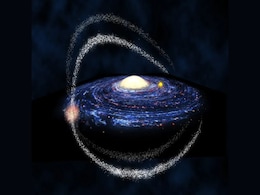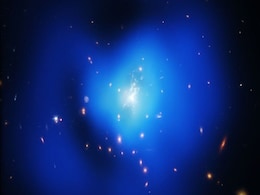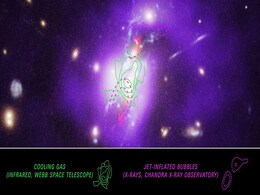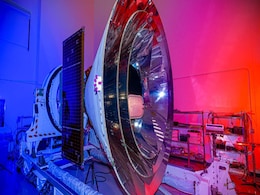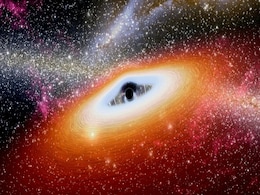Galaxy Formation
- All
- News
-

Astronomers Discover Potential ‘Dark Galaxy’ Near the Milky Way
- Monday April 21, 2025
- Written by Gadgets 360 Staff
Astronomers have spotted a massive hydrogen cloud near the Milky Way that may be a rare dark galaxy—an object composed of gas and dark matter but lacking stars and light. Detected through radio telescopes, the galaxy-like structure challenges conventional astronomy and could reveal hidden phases of galaxy formation and dark matter interaction in ...
-
 www.gadgets360.com
www.gadgets360.com
-

NASA’s Hubble Space Telescope Shares Detailed Mosaic of the Sombrero Galaxy
- Friday April 18, 2025
- Written by Gadgets 360 Staff
NASA’s Hubble reveals a detailed view of the Galactic favourite, the Sombrero Galaxy, telling about the rare shape of the galaxy. The Sombrero Galaxy is found to have metal-rich stars in its outer region. This research has a future scope of getting deeper insights into its formation by using the advanced imaging technique of Hubble.
-
 www.gadgets360.com
www.gadgets360.com
-

Did Black Hole Radiation Shape the Universe?
- Saturday March 29, 2025
- Written by Gadgets 360 Staff
A study suggests that Hawking radiation, first proposed by Stephen Hawking, may have influenced the universe’s structure. According to reports, primordial black holes that existed in the early universe could have evaporated through Hawking radiation, impacting matter distribution. The research explores how these black holes might have shaped gala...
-
 www.gadgets360.com
www.gadgets360.com
-

Hubble Telescope Captures NGC 4536, a Starburst Galaxy with Intense Star Formation
- Wednesday March 26, 2025
- Written by Gadgets 360 Staff
NASA’s Hubble Space Telescope has captured a striking image of NGC 4536, a starburst galaxy 50 million light-years away in the Virgo constellation. The galaxy’s sweeping spiral arms are filled with young blue star clusters and ionized hydrogen gas, indicating rapid star formation. Astronomers believe its bar-like structure channels gas toward t...
-
 www.gadgets360.com
www.gadgets360.com
-

Smallest Galaxy Ever Found: Andromeda XXXV Defies Cosmic Evolution Models
- Thursday March 13, 2025
- Written by Gadgets 360 Staff
Astronomers have discovered Andromeda XXXV, the smallest and faintest known galaxy, located 3 million light-years away. It challenges existing models of galaxy formation, as similar small galaxies were thought to be destroyed in the early universe. Researchers are studying how it retained conditions for star formation despite harsh cosmic environme...
-
 www.gadgets360.com
www.gadgets360.com
-

Water May Have Formed in the Universe 100 Million Years After Big Bang
- Thursday March 13, 2025
- Written by Gadgets 360 Staff
A new study suggests water formed in the universe just 100–200 million years after the Big Bang, much earlier than previously estimated. Researchers examined ancient supernovas to understand how oxygen combined with hydrogen to create water. If confirmed, these findings could change perspectives on when the conditions for life first emerged. The ...
-
 www.gadgets360.com
www.gadgets360.com
-

Video: NASA Launches SPHEREx Telescope To Explore Universe's Origins
- Wednesday March 12, 2025
- World News | Reuters
A NASA telescope was launched into space from California on Tuesday for a mission to explore the origins of the universe and to scour the Milky Way galaxy for hidden reservoirs of water, a key ingredient for life.
-
 www.ndtv.com
www.ndtv.com
-

Unexpected Rotational Motion Detected in Ultra-Diffuse Galaxies of Hydra Cluster
- Wednesday March 5, 2025
- Written by Gadgets 360 Staff
Astronomers studying ultra-diffuse galaxies (UDGs) in the Hydra cluster have observed unexpected rotational movement in nearly half of the 30 galaxies examined. Spectroscopic data from the LEWIS programme, using the MUSE instrument on the Very Large Telescope, suggests that gravitational interactions with larger galaxies may influence their formati...
-
 www.gadgets360.com
www.gadgets360.com
-

JWST Identifies Cooling Gas in Phoenix Cluster, Unlocking Star Formation Process
- Thursday February 20, 2025
- Written by Gadgets 360 Staff
The James Webb Space Telescope has detected the missing cooling gas in the Phoenix Cluster, a galaxy cluster located 5.8 billion light-years away. Researchers used the Mid-Infrared Instrument (MIRI) to identify gas at around 540,000 degrees Fahrenheit trapped in cavities within the cluster. This discovery resolves a long-standing mystery of how sta...
-
 www.gadgets360.com
www.gadgets360.com
-

Webb Telescope Unveils Hidden Process Behind Star Formation in Phoenix Cluster
- Friday February 14, 2025
- Written by Gadgets 360 Staff
NASA’s James Webb Space Telescope has uncovered the missing link in star formation within the Phoenix galaxy cluster. By mapping intermediate-temperature gas, researchers identified a crucial phase of cooling that was previously undetected. This discovery explains why the cluster’s supermassive black hole does not fully prevent star formation, ...
-
 www.gadgets360.com
www.gadgets360.com
-

SPHEREx Space Telescope to Map Cosmos in Infrared Light, Launching in February 2025
- Tuesday February 4, 2025
- Written by Gadgets 360 Staff
Set to launch in February 2025, NASA’s SPHEREx mission will provide a comprehensive map of the universe in infrared light. The telescope will examine 450 million galaxies and 100 million stars, shedding light on the universe’s formation, early conditions after the Big Bang, and the presence of water in planetary systems. SPHEREx will survey the...
-
 www.gadgets360.com
www.gadgets360.com
-

JWST Detects Unexpectedly Massive Black Holes in the Early Universe
- Monday February 3, 2025
- Written by Gadgets 360 Staff
A new study led by Jorryt Matthee of ISTA reveals that black holes in early galaxies were significantly more massive than expected. Using JWST data, researchers found that some black holes accounted for nearly 10% of their galaxy's stellar mass—far exceeding the 0.01% ratio seen in modern galaxies. The findings challenge existing growth models, s...
-
 www.gadgets360.com
www.gadgets360.com
-

Researchers Spot Unusual, Overmassive Globular Clusters in Ultra-Diffuse Galaxy FCC 224
- Friday January 31, 2025
- Written by Gadgets 360 Staff
A new study has uncovered an unexpected globular cluster system in FCC 224, an ultra-diffuse galaxy located in the Fornax cluster. Using data from the Hubble Space Telescope and the Keck Cosmic Web Imager, researchers found that FCC 224 hosts luminous, overmassive globular clusters with unusual properties. The galaxy’s star clusters exhibit narro...
-
 www.gadgets360.com
www.gadgets360.com
-

NASA SPHEREx Telescope to Map the Universe and Search for Life’s Ingredients
- Thursday January 30, 2025
- Written by Gadgets 360 Staff
NASA’s SPHEREx mission, set to launch aboard a SpaceX Falcon 9 rocket on February 27, aims to explore the origins of the universe and the formation of galaxies. Using near-infrared light, the telescope will study over 450 million galaxies and 100 million stars in the Milky Way. It will also search for water and organic molecules in regions where ...
-
 www.gadgets360.com
www.gadgets360.com
-

Astronomers Capture Supermassive Black Hole Plasma Jets at Birth
- Tuesday January 28, 2025
- Written by Gadgets 360 Staff
For the first time, plasma jets from a supermassive black hole have been observed in real time. Located 270 million light-years away in galaxy 1ES 1927+654, the jets traveled at one-third the speed of light. Emerging in 2024 after a radio flare in 2023, the jets broke through dense gas near the black hole, which has a mass 1.4 billion times that of...
-
 www.gadgets360.com
www.gadgets360.com
-

Astronomers Discover Potential ‘Dark Galaxy’ Near the Milky Way
- Monday April 21, 2025
- Written by Gadgets 360 Staff
Astronomers have spotted a massive hydrogen cloud near the Milky Way that may be a rare dark galaxy—an object composed of gas and dark matter but lacking stars and light. Detected through radio telescopes, the galaxy-like structure challenges conventional astronomy and could reveal hidden phases of galaxy formation and dark matter interaction in ...
-
 www.gadgets360.com
www.gadgets360.com
-

NASA’s Hubble Space Telescope Shares Detailed Mosaic of the Sombrero Galaxy
- Friday April 18, 2025
- Written by Gadgets 360 Staff
NASA’s Hubble reveals a detailed view of the Galactic favourite, the Sombrero Galaxy, telling about the rare shape of the galaxy. The Sombrero Galaxy is found to have metal-rich stars in its outer region. This research has a future scope of getting deeper insights into its formation by using the advanced imaging technique of Hubble.
-
 www.gadgets360.com
www.gadgets360.com
-

Did Black Hole Radiation Shape the Universe?
- Saturday March 29, 2025
- Written by Gadgets 360 Staff
A study suggests that Hawking radiation, first proposed by Stephen Hawking, may have influenced the universe’s structure. According to reports, primordial black holes that existed in the early universe could have evaporated through Hawking radiation, impacting matter distribution. The research explores how these black holes might have shaped gala...
-
 www.gadgets360.com
www.gadgets360.com
-

Hubble Telescope Captures NGC 4536, a Starburst Galaxy with Intense Star Formation
- Wednesday March 26, 2025
- Written by Gadgets 360 Staff
NASA’s Hubble Space Telescope has captured a striking image of NGC 4536, a starburst galaxy 50 million light-years away in the Virgo constellation. The galaxy’s sweeping spiral arms are filled with young blue star clusters and ionized hydrogen gas, indicating rapid star formation. Astronomers believe its bar-like structure channels gas toward t...
-
 www.gadgets360.com
www.gadgets360.com
-

Smallest Galaxy Ever Found: Andromeda XXXV Defies Cosmic Evolution Models
- Thursday March 13, 2025
- Written by Gadgets 360 Staff
Astronomers have discovered Andromeda XXXV, the smallest and faintest known galaxy, located 3 million light-years away. It challenges existing models of galaxy formation, as similar small galaxies were thought to be destroyed in the early universe. Researchers are studying how it retained conditions for star formation despite harsh cosmic environme...
-
 www.gadgets360.com
www.gadgets360.com
-

Water May Have Formed in the Universe 100 Million Years After Big Bang
- Thursday March 13, 2025
- Written by Gadgets 360 Staff
A new study suggests water formed in the universe just 100–200 million years after the Big Bang, much earlier than previously estimated. Researchers examined ancient supernovas to understand how oxygen combined with hydrogen to create water. If confirmed, these findings could change perspectives on when the conditions for life first emerged. The ...
-
 www.gadgets360.com
www.gadgets360.com
-

Video: NASA Launches SPHEREx Telescope To Explore Universe's Origins
- Wednesday March 12, 2025
- World News | Reuters
A NASA telescope was launched into space from California on Tuesday for a mission to explore the origins of the universe and to scour the Milky Way galaxy for hidden reservoirs of water, a key ingredient for life.
-
 www.ndtv.com
www.ndtv.com
-

Unexpected Rotational Motion Detected in Ultra-Diffuse Galaxies of Hydra Cluster
- Wednesday March 5, 2025
- Written by Gadgets 360 Staff
Astronomers studying ultra-diffuse galaxies (UDGs) in the Hydra cluster have observed unexpected rotational movement in nearly half of the 30 galaxies examined. Spectroscopic data from the LEWIS programme, using the MUSE instrument on the Very Large Telescope, suggests that gravitational interactions with larger galaxies may influence their formati...
-
 www.gadgets360.com
www.gadgets360.com
-

JWST Identifies Cooling Gas in Phoenix Cluster, Unlocking Star Formation Process
- Thursday February 20, 2025
- Written by Gadgets 360 Staff
The James Webb Space Telescope has detected the missing cooling gas in the Phoenix Cluster, a galaxy cluster located 5.8 billion light-years away. Researchers used the Mid-Infrared Instrument (MIRI) to identify gas at around 540,000 degrees Fahrenheit trapped in cavities within the cluster. This discovery resolves a long-standing mystery of how sta...
-
 www.gadgets360.com
www.gadgets360.com
-

Webb Telescope Unveils Hidden Process Behind Star Formation in Phoenix Cluster
- Friday February 14, 2025
- Written by Gadgets 360 Staff
NASA’s James Webb Space Telescope has uncovered the missing link in star formation within the Phoenix galaxy cluster. By mapping intermediate-temperature gas, researchers identified a crucial phase of cooling that was previously undetected. This discovery explains why the cluster’s supermassive black hole does not fully prevent star formation, ...
-
 www.gadgets360.com
www.gadgets360.com
-

SPHEREx Space Telescope to Map Cosmos in Infrared Light, Launching in February 2025
- Tuesday February 4, 2025
- Written by Gadgets 360 Staff
Set to launch in February 2025, NASA’s SPHEREx mission will provide a comprehensive map of the universe in infrared light. The telescope will examine 450 million galaxies and 100 million stars, shedding light on the universe’s formation, early conditions after the Big Bang, and the presence of water in planetary systems. SPHEREx will survey the...
-
 www.gadgets360.com
www.gadgets360.com
-

JWST Detects Unexpectedly Massive Black Holes in the Early Universe
- Monday February 3, 2025
- Written by Gadgets 360 Staff
A new study led by Jorryt Matthee of ISTA reveals that black holes in early galaxies were significantly more massive than expected. Using JWST data, researchers found that some black holes accounted for nearly 10% of their galaxy's stellar mass—far exceeding the 0.01% ratio seen in modern galaxies. The findings challenge existing growth models, s...
-
 www.gadgets360.com
www.gadgets360.com
-

Researchers Spot Unusual, Overmassive Globular Clusters in Ultra-Diffuse Galaxy FCC 224
- Friday January 31, 2025
- Written by Gadgets 360 Staff
A new study has uncovered an unexpected globular cluster system in FCC 224, an ultra-diffuse galaxy located in the Fornax cluster. Using data from the Hubble Space Telescope and the Keck Cosmic Web Imager, researchers found that FCC 224 hosts luminous, overmassive globular clusters with unusual properties. The galaxy’s star clusters exhibit narro...
-
 www.gadgets360.com
www.gadgets360.com
-

NASA SPHEREx Telescope to Map the Universe and Search for Life’s Ingredients
- Thursday January 30, 2025
- Written by Gadgets 360 Staff
NASA’s SPHEREx mission, set to launch aboard a SpaceX Falcon 9 rocket on February 27, aims to explore the origins of the universe and the formation of galaxies. Using near-infrared light, the telescope will study over 450 million galaxies and 100 million stars in the Milky Way. It will also search for water and organic molecules in regions where ...
-
 www.gadgets360.com
www.gadgets360.com
-

Astronomers Capture Supermassive Black Hole Plasma Jets at Birth
- Tuesday January 28, 2025
- Written by Gadgets 360 Staff
For the first time, plasma jets from a supermassive black hole have been observed in real time. Located 270 million light-years away in galaxy 1ES 1927+654, the jets traveled at one-third the speed of light. Emerging in 2024 after a radio flare in 2023, the jets broke through dense gas near the black hole, which has a mass 1.4 billion times that of...
-
 www.gadgets360.com
www.gadgets360.com

